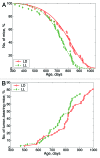Exposure to light at night accelerates aging and spontaneous uterine carcinogenesis in female 129/Sv mice
- PMID: 23656779
- PMCID: PMC3713136
- DOI: 10.4161/cc.24879
Exposure to light at night accelerates aging and spontaneous uterine carcinogenesis in female 129/Sv mice
Abstract
The effect of the constant illumination on the development of spontaneous tumors in female 129/Sv mice was investigated. Forty-six female 129/Sv mice starting from the age of 2 mo were kept under standard light/dark regimen [12 h light (70 lx):12 hr dark; LD, control group], and 46 of 129/Sv mice were kept under constant illumination (24 h a day, 2,500 lx, LL) from the age of 5 mo until to natural death. The exposure to the LL regimen significantly accelerated body weight gain, increased body temperature as well as acceleration of age-related disturbances in estrous function, followed by significant acceleration of the development of the spontaneous uterine tumors in female 129/Sv mice. Total tumor incidence as well as a total number of total or malignant tumors was similar in LL and LD group (p > 0.05). The mice from the LL groups survived less than those from the LD group (χ ( 2) = 8.5; p = 0.00351, log-rank test). According to the estimated parameters of the Cox's regression model, constant light regimen increased the relative risk of death in female mice compared with the control (LD) group (p = 0.0041). The data demonstrate in the first time that the exposure to constant illumination was followed by the acceleration of aging and spontaneous uterine tumorigenesis in female 129/Sv mice.
Keywords: 129/Sv mice; lifespan; light at night; tumorigenesis.
Figures


Similar articles
-
Light-at-night-induced circadian disruption, cancer and aging.Curr Aging Sci. 2012 Dec;5(3):170-7. doi: 10.2174/1874609811205030002. Curr Aging Sci. 2012. PMID: 23237593
-
Effect of exposure to light-at-night on life span and spontaneous carcinogenesis in female CBA mice.Int J Cancer. 2004 Sep 10;111(4):475-9. doi: 10.1002/ijc.20298. Int J Cancer. 2004. PMID: 15239122
-
The effect of light regimen and melatonin on the development of spontaneous mammary tumors in HER-2/neu transgenic mice is related to a downregulation of HER-2/neu gene expression.Neuro Endocrinol Lett. 2001 Dec;22(6):441-7. Neuro Endocrinol Lett. 2001. PMID: 11781542
-
The light-dark regimen and cancer development.Neuro Endocrinol Lett. 2002 Jul;23 Suppl 2:28-36. Neuro Endocrinol Lett. 2002. PMID: 12163845 Review.
-
Light pollution, reproductive function and cancer risk.Neuro Endocrinol Lett. 2006 Feb-Apr;27(1-2):35-52. Neuro Endocrinol Lett. 2006. PMID: 16648818 Review.
Cited by
-
Co-administering Melatonin With an Estradiol-Progesterone Menopausal Hormone Therapy Represses Mammary Cancer Development in a Mouse Model of HER2-Positive Breast Cancer.Front Oncol. 2019 Jul 9;9:525. doi: 10.3389/fonc.2019.00525. eCollection 2019. Front Oncol. 2019. PMID: 31355130 Free PMC article.
-
Medical hypothesis: Light at night is a factor worth considering in critical care units.Adv Integr Med. 2017 Dec;4(3):115-120. doi: 10.1016/j.aimed.2017.12.001. Epub 2017 Dec 21. Adv Integr Med. 2017. PMID: 34094846 Free PMC article.
-
Expansion of CD11b+Ly6Ghigh and CD11b+CD49d+ myeloid cells with suppressive potential in mice with chronic inflammation and light-at-night-induced circadian disruption.Inflamm Res. 2017 Aug;66(8):711-724. doi: 10.1007/s00011-017-1052-4. Epub 2017 Apr 28. Inflamm Res. 2017. PMID: 28455608
References
-
- Arendt J. Melatonin and the Mammalian Pineal Gland. London: Chapman & Hall, 1995.
Publication types
MeSH terms
LinkOut - more resources
Full Text Sources
Other Literature Sources
Medical
Research Materials
